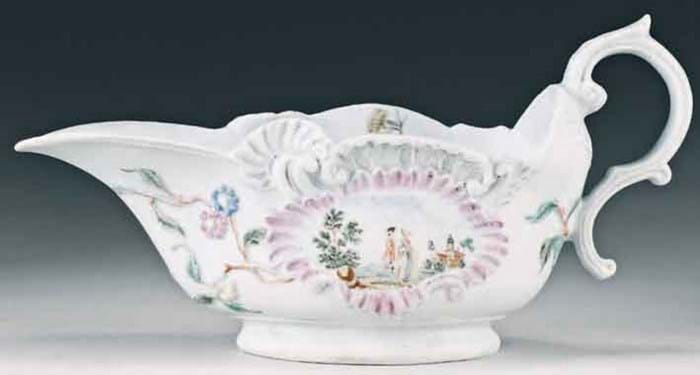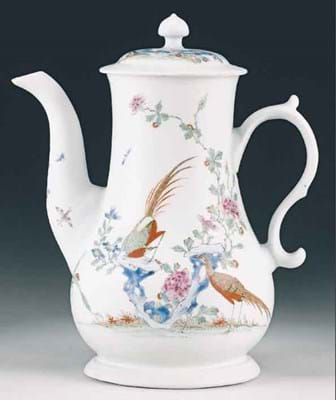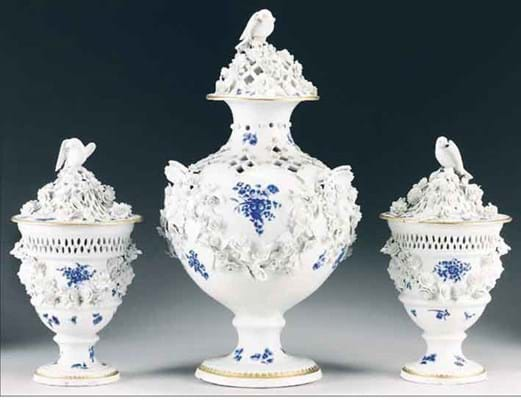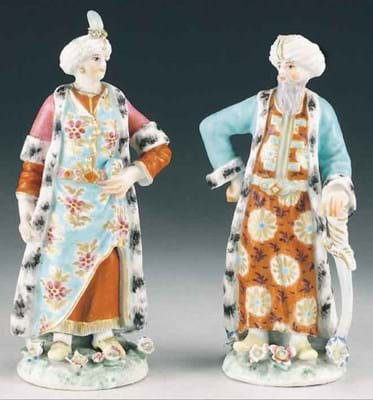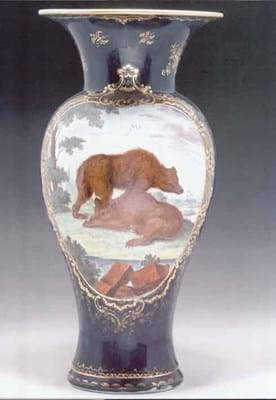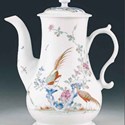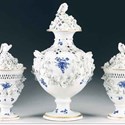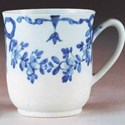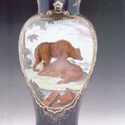Back in 1971 the couple embarked on a quest to build up the most comprehensive possible collection of the factory's First Period wares. Thirty-odd years, over 1400 pieces and many thousands of dollars later they had achieved their goal and had published a major reference work devoted to their collection into the bargain, Worcester Porcelain 1751-1790: The Zorensky Collection.
The fruits of their labours are housed in their St Louis apartment in large cabinets where they are grouped by Jeanne Zorensky according to colour rather than chronology. But with both the Zorenskys in advancing years and their interest and knowledge of Worcester not shared by their children, the couple decided that it was time to think about dispersing the fruits of their 33- year collecting quest.
Dispersing a collection of this size is no easy task.
True, Worcester collectors are more numerous than those of other less prolific concerns but, even so, finding buyers without swamping the market could be difficult, especially when one adds other factors into the mix. The Zorenskys' desire for comprehensiveness meant a) that damaged pieces were incorporated where no perfect example could be obtained; b) that the collection also contained representative examples of the factory's standard fare; and c) that it featured material that did not come from the voguishly early years of factory production. In short, once the collection was divided up for sale, how would the market respond to damaged, unfashionable or frankly ordinary pieces?
Evidently this was a dispersal that would need a careful sales strategy.
The Zorenskys took their collection to Bonhams - or more specifically to John Sandon, who co-authored with Simon Spero the Antique Collectors' Club book on their collection. This wasn't their only reason for choosing the firm.
The auctioneers also have a particularly good track record with major single-owner dispersals (vide the Watney, Stretton, Pinewood and Paine collections to name the most recent and prominent).
The flooding-the-market problem was countered by dividing the collection into three tranches, each containing a similar cross section of material with considerable time left between the sale of each (the precise date of part two has yet to be determined but is unlikely to be before this time next year).
Finding enough buyers for the quantities of less fashionable or more ordinary fare that was of limited appeal to the trade needed a different approach. Short of finding a buyer who wished to duplicate the Zorenskys' comprehensive objective, Bonhams needed an influx of novice Worcester fanciers keen to start collecting.
Their promotional strategy was to make a feature of the very affordable nature of this material while also stressing the attractions of buying from a published provenance: "Collectors will be able to bid for porcelain with a world-class provenance with prices to suit every pocket. It will.... be possible to buy special pieces... that have been illustrated in one of the most important reference books, for as little as £100 or £150" was John Sandon's promotional line.
As to the damage, market reaction to this was harder to predict, especially given that Bonhams themselves had only recently sold much well-preserved rare Worcester from Billie Paine's collection. One solution was to estimate very realistically and to allow some discretion with reserves.
A good view with plenty of pre-sale interest augured well for the auctioneers as did the turnout on the day with a full room. The final results confirmed the success of their campaign - just five of the 416 lots remained unsold (and all of those found homes immediately afterwards) for a total of around £500,000. Looking to the buying breakdown, there was relatively little telephone input, with most of the competition in the room, a sign, perhaps, that the strength of sterling was making Americans rein in their spending power.
Nonetheless, the spread of buyers was also impressive. There were no fewer than 103 different purchasers, less than 20 of whom were dealers, so an unusually high proportion of buying came from collectors. And judging by the faces in the room that were unfamiliar to many of the 'regulars', some of those hoped-for new buyers appear to have emerged. Some of the Zorenskys' family attended the sale and they seemed pleased with the outcome with their son Mark observing at the halfway mark that the sale was progressing along the lines that his parents had predicted.
So, objective achieved in terms of an overall result, but how did the individual pieces fare? What's hot and what's not in the Worcester enthusiast's world?
Top lot
No surprises about the sale's best-seller, the pair of 11.5in (30cm) high iron-red and shagreen ground hexagonal mid- to late-1760s vases featuring Japanese kakiemon-inspired decoration of dragons coiled around bamboo. They had always been billed as the most expensive pieces in the sale, with an estimate of £14,000-16,000 (although this was not much more than the £13,000 the pair fetched when they were purchased by Steppes Hill Farm Antiques at Christie's auction of the Phelps Collection in 1984).
Three telephones were lined up for these and there was a commission bid as well, but most of the competition came from the room. Bidding opened at £10,000 and swiftly rose to double predictions, with the competition coming from London dealers Simon Spero and Robyn Robb against Mark Law, who managed to secure them for £29,000.
Mr Law said the pair would feature in the summer exhibition in his St James's shop Albert Amor this June. A prime attraction was their good condition and their rarity. (Mr Law reckoned it is 20 years since Amor's last featured a comparable pair, in their 1984 exhibition of the Wills Collection).
Following in price was a much earlier piece, a c.1754-56 polychrome-decorated sauceboat inspired by a rococo silver shape moulded with prunus flowers and decorated with two Meissen-type landscape vignettes to the exterior and scattered sprigs and insects to the inside. The object of a bidding battle between a collector and the successful purchaser, London dealer Simon Spero, acting in this instance on behalf of a client, this sailed past the £4500-5500 predictions to reach £13,000.
Significantly, condition was not a factor with either of these entries, the vases being undamaged and the sauceboat having just a minute rim chip. These and the blue scale coffee cup and saucer illustrated on the front page of last week's ATG were some of the most dramatic instances of the premium attached to perfection, others being illustrated here.
Cool start
On the other side of the coin, condition problems could plainly be seen to hold back some pieces. This was most notable with the first 20-odd lots of polychrome pieces dating from 1751-55, not least because this early academic period has been voguishly collectable for some time.
All else being equal, one might have expected prices to mirror those seen in the Billie Paine sale, but there was a general post-sale acknowledgement that the mood was reticent in this opening section.
A 5in (13cm) tall wine funnel of c.1754, polychrome painted with a Long Eliza figure standing by two pine trees, was surely one of those Zorensky purchases Simon Spero had in mind when he noted in the catalogue introduction that "no rarity was ever rejected on grounds of damage". This was broken and restuck with three filled missing sections, but was an early rarity nonetheless. He was able to purchase it for £1050, comfortably under the £1400- 1500 estimate.
At least there was enough demand to see it sell, unlike the opening lot of the day, a small cylindrical coffee cup of c.1756, finely pencilled and painted in bright enamels with a continuous Chinese landscape. A patch of misfiring above the foot and a small rim chip seemed to make an estimate of £4000- 5000 too much for the room to wear, and the piece was bought in (although it sold after the sale).
Perhaps the biggest surprise was the lukewarm response to a covered sucrier of c.1753 decorated with sprigs and flowers. True, this had several chips plus restoration to the rim and knop, but it was a piece with a double pedigree, having been acquired by the Zorenksys from Sotheby's landmark 1986 sale of the Rous Lench collection. Then, catalogued, incidentally as Lund's Bristol /early Worcester, Jeanne Zorenksy paid £1850 for it. This time Bonhams had hopes of £7000-9000, but Simon Spero took it for the relatively bargain price of £4800.
Talking after the sale, John Sandon felt that the shape and size of this piece might not have been in its favour. "Today's buyers like little coffee cans and cream boats that do not require much display space," he said.
Size certainly did seem to matter, with small definitely favoured over large. One of the biggest pieces in the sale was a 101/2in (26.5cm) high cabbage leaf mask jug of pale lemon ground.
It had some restoration to the spout but it featured on the catalogue cover and on the frontispiece where the Zorenskys were shown holding it, while the very fine quality puce chinoiserie landscape panels on its body were reproduced on the catalogue endpapers.
No shortage of exposure for this piece then, but Mark Law ended up buying it for Amor's against a London collector for a mid-estimate £5000.
Sèvres-inspired
One of the more interesting features of the Zorensky sale was the strong performance of some of the less fashionable, non-academic Worcester. The strength of the blue scale wares has already been noted, but some of the later, 1770s and 80s French or Sèvres-inspired teawares were also shooting away and cups and saucers generally seemed to be much in demand.
A reeded teabowl and saucer with Sèvres-style decoration of turquoise caillouté panels and mignonette swags, an attractive lot but not an exceptional rarity and with minor chips and enamel wear, doubled estimate at £1100, a price that seemed well up on retail. A little earlier, two 1780s trios of French shape trebled and doubled their respective estimates to sell for £1400 and £1200.
These both went to someone who had left what were obviously hefty commission bids.
Of course not all the non-academic things flew away. A 1770s white garniture of three covered Worcester vases with pierced shoulders, applied cascades of flowers, bird finials and underglaze blue sprigs, was secured by Mark Law for a lower-estimate £4000.
There were repairs to some of the covers and one rim and minor chipping to the extremities, but again their large size - the biggest stood at 16.5in (41cm) - was probably their biggest disadvantage.
But even if some of the prices for the standard or unfashionable pieces weren't head-turning, the fact that they managed to find buyers at all is noteworthy, especially given the degree of damage. One wonders if this would have been the case in any mixed-owner regular ceramics sale. At least some of that high take-up must be down to the "Zorensky effect", the attraction of owning a high-profile provenanced piece that has been published in a notable book.
Talking after the sale, Simon Spero felt this was a key factor. "There is one thing that makes this auction unique. When people viewed the sale they were familiar with it before hand", he said. They had been able to look through the Zorensky book and see what pieces they might like to own, a feature which seems to have greatly appealed to collectors.
Collectors undoubtedly had a big impact on this event. To see private purchasers contesting and carrying off more than a dozen pieces is not common at auction. It would be wrong though, to leave the impression that the trade were inactive or that they didn't come away with anything for their shops.
Apart from the dealers already mentioned, other busy players included Jupiter Antiques, active throughout the sale; Stockspring and Roderick Jellicoe, who was particularly busy in the section on pieces with Chinese-influenced decoration, stocking up for a special exhibition in his shop later this year.


